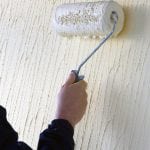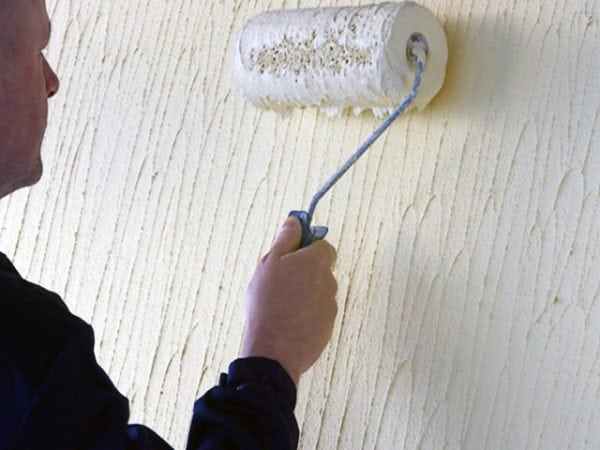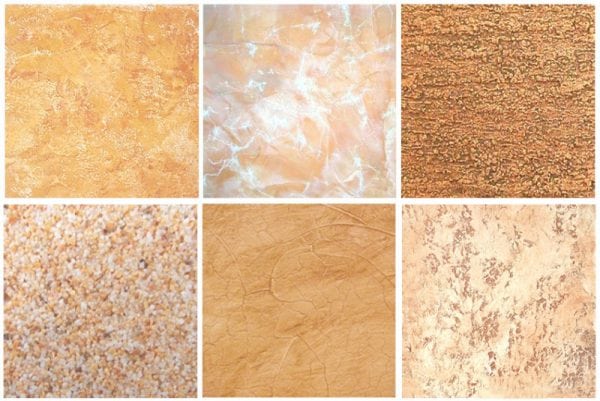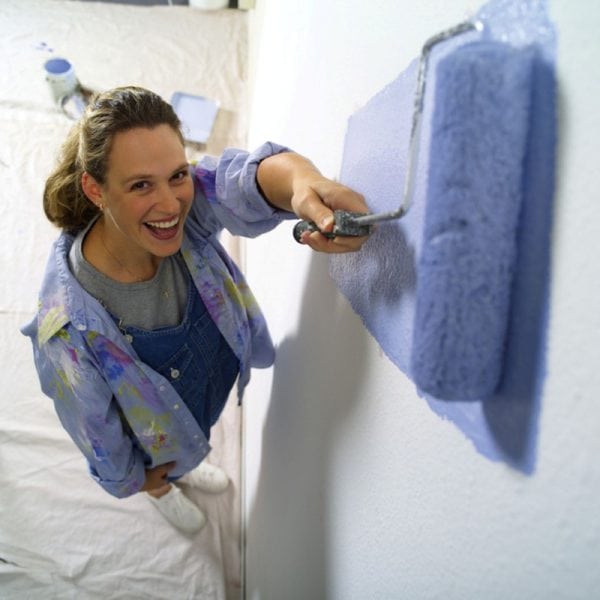How to complete the exterior design of the house? Use the finish, which gives the surface of the walls an aesthetically attractive appearance, sets a beautiful background for the entire structure and protects the building from external effects of rain for a long time. As a final finish, you can use structural facade paint. Its main advantages are a rich color palette and an interesting texture.
- Varieties of paint material
- Vinyl
- Acrylic
- Silicone
- Polymer or silicate
- Mineral
- Application Formulations
- Benefits of Using Volumetric Trim

Varieties of paint material
Manufacturers offer an extensive assortment of paints for performing exterior home finishing work. All materials differ in binding components, composition, consistency, color and method of applying a relief pattern on the walls. The following materials are distinguished for painting facades.
Vinyl
Used exclusively for outdoor work. The binder component is vinyl filler, or plastic. They have high adhesive properties, but have low permeability. The advantages include the ability to apply vinyl materials on any surface and good protection against negative external influences. The paint is difficult to work: the plasticity of the material makes it difficult to apply a textured pattern.
to contents ↑Acrylic
They have a water base and a rich color spectrum. They are very popular due to their plasticity. You can create intricate reliefs of any complexity. It is easy to breed components to any consistency and shade, using color paste. The composition does not contain harmful substances and is completely safe for health. Acrylic paints are poorly protected from sunlight and chemical solvents.
Silicone
These exterior paints are very durable. They reliably protect facades from negative factors, are resistant to fading and moisture, and are vapor permeable. Silicone paint material has good ductility and viscosity, so that the walls of the house can give an original volumetric texture. Such a structural facade paint masks well defects and defects of the processed surface.
Polymer or silicate
The main component of the material for exterior painting of facades is liquid glass. It has high vapor permeability and good adhesive properties. At the same time, decorative polymers repel moisture, dust and dirt, have a long service life, reliably protect the walls from external influences, but significant amounts of materials are required for work.
Mineral
These compositions for coloring are made on the basis of cement. They are vapor permeable and moisture resistant, fit beautifully into a texture pattern, have an attractive relief. But the mineral components are unstable to sudden temperature changes, and as a result of winter frosts, the pattern may crack.
to contents ↑When choosing finishing materials, it is necessary to consider what surface the paint will be applied to. Typically, the manufacturer indicates for which facades a particular material is suitable. Textured paint for facades is a reliable decorative composition that simultaneously decorates walls and protects them from many negative factors.
Application Formulations
Structural paint for finishing work is applied to different surfaces - concrete, brick, plastered, wooden. Walls can be new or previously treated with textured or plaster. Much depends on the application technique and the tools used. For work apply:
- Rollers. In construction stores they sell a wide variety of nozzles with interesting patterns designed for decoration of facades. This method is simple, so you can quickly create original reliefs yourself.
- Trowels. They are used when applying coloring compositions with a thick consistency, as if rubbing them into the surface of the wall. Due to the varying force of pressure on the trowel, a pattern similar to the paintings of expressionist painters is obtained on the wall.
- Applicators A fairly simple option for applying a texture pattern. First of all, all the material is applied to the surface of the walls, and then an applicator with a textured pattern is used and they pass along the entire surface of the external walls.
- Spray guns. Apply for work with more liquid paints if the tool is electric. When using pneumatic spray guns, any textured materials can be applied. Only facade specialists can work in this application technique.
- Teflon spatulas. The tool is periodically wetted with water and gently held on the surface of the facades to draw filler particles from the mixture, forming a structural pattern. Using this application technique, you can get a popular bark beetle relief.
to contents ↑The appearance of the finished surface depends on the consistency, viscosity and adhesion of the selected coloring composition. Using various tools and methods of forming drawings, it is possible to give facades original volumetric reliefs.
Benefits of Using Volumetric Trim
Using structural decorative paint, the facades can be painted in any color, set an interesting direction for the pattern, and use combined work options. The relief coating has important advantages that help preserve the beautiful appearance of the facades and prevent the negative impact of external factors. Advantages of textured paints:
- Staining can be done without thorough surface preparation. The relief coating layer is up to 10 mm, overlapping minor flaws.
- Almost all paints are distinguished by good permeability, moisture resistance and adhesiveness.
- Decorative paint better protects walls from external influences than plastering, prevents the penetration of moisture and repels dust and dirt.
- Textured materials can be applied to all surfaces and create a large number of patterns and shades.
- Paints are suitable for tinting and mixing with other components, they do not emit toxic substances.
The only drawback of textured painting of external walls is the high consumption of materials. To create complex three-dimensional drawings, you need to apply paint with a thick layer. This helps to get the desired effect.
If you are tired of even monophonic facades, textured decorative paint is an excellent solution to revive the color and texture of the walls and add an interesting highlight to the design of the building.







